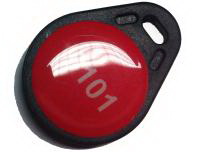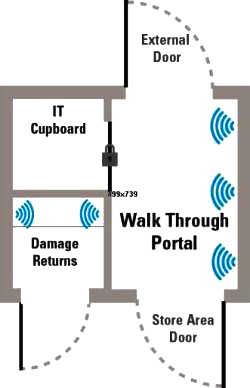Az IFSEC 2012 győztes beléptetőrendszere
A 2012-es Ifsecen az év beléptetőrendszere címet a Codegate ePod automatikus, személyzet nélküli beléptető és nyomkövető konténere nyerte. Az eszközt a Codegate a Speedy Services-zel közösen fejlesztette ki, és tőle bérelhető vagy vásárolható meg.
Az ePod beléptető konténert mindazon cégek számára ajánlják, amelyeknek olyan helyen van szükségük beléptetésre, ahol nincs személyzet. Bármilyen környezetben használható, akár építkezésen vagy vasúti, nukleáris, katonai, vegyipari létesítményekben. A helyszínre teherautóval szállítható, és ott egy targonca segítségével a kívánt helyen kell fölállítani.
Az ePod belső tere három részből áll
- RFID antennákkal ellátott átjáró
- biztonsági raktár, ahol szintén vannak RFID antennák
- IT-központ, ahol rendszer számítástechnikai központját helyezték el: a vezérlő modult, amely az RFID-olvasót, a GPRS kommunikációs eszközöket és az ipari számítógépet
A konténert fémből készült lábakkal rögzítik a talajhoz, 110 Volt vagy 240 Voltról működik, és szükség esetén szünetmentes áramforrás (UPS) biztosítja a folyamatos üzemet.
 A felhasználók alacsony frekvenciájú RFID kulcstartóval léphetnek be a védett területre a konténeren keresztül. A belépőt üdvözlő üzenetet fogadja, és igény szerint szóban tájékoztat a rendszer a készülék használatáról.
A felhasználók alacsony frekvenciájú RFID kulcstartóval léphetnek be a védett területre a konténeren keresztül. A belépőt üdvözlő üzenetet fogadja, és igény szerint szóban tájékoztat a rendszer a készülék használatáról.
Codegate ePod beléptetőrendszer valamennyi eseményt rögzíti, és az információkat GPRS-en keresztül valós időben továbbítja a távoli szerverre. Ezzel interneten keresztül valamennyi mozgás nyomon követhető.
www.codegate.co.uk

Unmanned access control and asset tracking module
The ePod is an unmanned, self contained, self-service rental / hire portal that can be inserted inside a standard shipping container. Developed in partnership with Speedy Services it is available for purchase or hire exclusively through Speedy.
The ePod is intended for organisations who need ready access to assets in a secure area but where it is not cost effective to have a manned facility. It is designed to withstand the harsh environment of a construction site and therefore could be used in a wide range of similar industries, including rail, nuclear, aerospace, military, and petrochemical.
It can be transported to site quickly and easily by lorry and installed using a standard forklift which slots into the reinforced ventilation ducts above the doorway.
Layout and installation
Inside, the ePod is divided into three chambers:
- A walk through portal, equipped with RFID antennas
- A damage store area, also equipped with RFID antennas
- An IT cupboard containing the brains of the system the Control Module, which incorporates RFID reader, GPRS communications, industrial computer and digital input / outputs. This area is locked to users.
The ePod is lifted into position using a standard fork lift, which slots into the reinforced ventilation ducts above the doorway.
Metal feet allow the ePod to be bolted in position. Electrical power required is 110v or 240v via Commando socket fittings, delivered through a side aperture into the locked IT cupboard. An uninterruptible power supply (UPS) ensures the ePod remains operational even if the external supply is lost temporarily. Lighting for the inside of the container or store area can connected and operated by the ePod’s built-in Passive Infra-Red (PIR) sensors.
Operation
The customer is issued a unique entry tag (low frequency RFID key fob) for each authorized ePod user. As a user approaches the ePod, a simple “traffic light” system reports the unit’s status: red means out of service, amber means currently in use, and green means ready and available. When the unit is available, the user simply swipes the entry tag to unlock the external door and enters the ePod. On entering, the user is greeted by an audible welcome message and talked through how to use the unit. Assets are simply carried in and out of the portal.
Asset tracking
All assets to be tracked by the ePod must be fitted with an RFID tag. All Speedy Services assets are supplied pre-tagged. For other assets Codegate can assist with the sourcing and positioning of tags.
Once tags are correctly fitted any movement through the ePod will be recorded together with the identity of the individual who carried them. This information is communicated immediately over GPRS back to the remote servers allowing movements to be monitored via a web portal.

